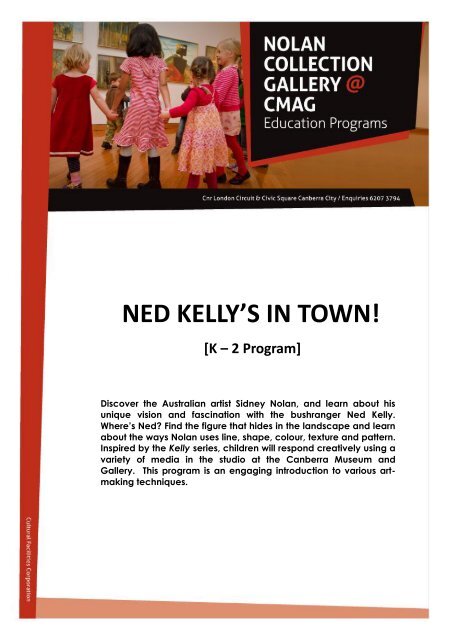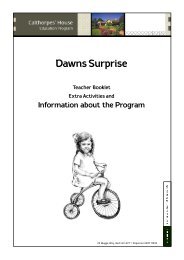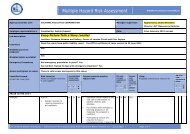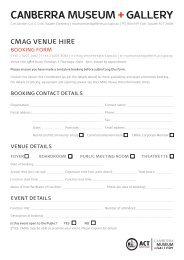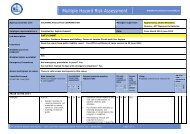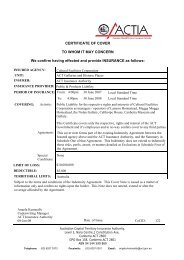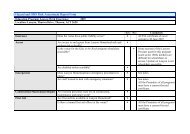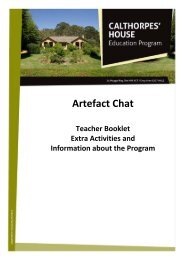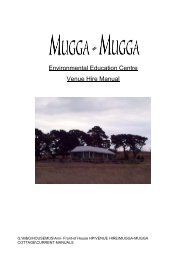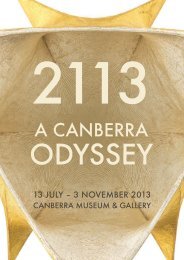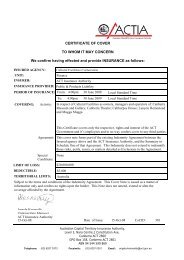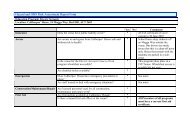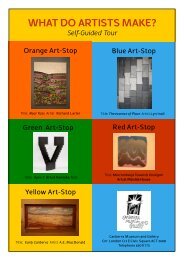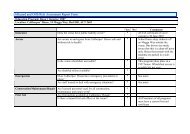Ned Kelly's in Town previsit information. - ACT Museums and Galleries
Ned Kelly's in Town previsit information. - ACT Museums and Galleries
Ned Kelly's in Town previsit information. - ACT Museums and Galleries
You also want an ePaper? Increase the reach of your titles
YUMPU automatically turns print PDFs into web optimized ePapers that Google loves.
NED KELLY’S IN TOWN![K – 2 Program]Discover the Australian artist Sidney Nolan, <strong>and</strong> learn about hisunique vision <strong>and</strong> fasc<strong>in</strong>ation with the bushranger <strong>Ned</strong> Kelly.Where’s <strong>Ned</strong>? F<strong>in</strong>d the figure that hides <strong>in</strong> the l<strong>and</strong>scape <strong>and</strong> learnabout the ways Nolan uses l<strong>in</strong>e, shape, colour, texture <strong>and</strong> pattern.Inspired by the Kelly series, children will respond creatively us<strong>in</strong>g avariety of media <strong>in</strong> the studio at the Canberra Museum <strong>and</strong>Gallery. This program is an engag<strong>in</strong>g <strong>in</strong>troduction to various artmak<strong>in</strong>gtechniques.
INFORMATION FOR TEACHERS<strong>Ned</strong> Kelly’s <strong>in</strong> <strong>Town</strong>! Is an early childhood program for children <strong>in</strong> years K – 2. Theprogram aims to:Introduce children to the work of Sidney Nolan, to learn about his uniquevision <strong>and</strong> fasc<strong>in</strong>ation with the bushranger <strong>Ned</strong> Kelly.Explore the figure <strong>in</strong> the l<strong>and</strong>scape as subject matter.Investigate visual elements such as l<strong>in</strong>e, colour, shape, texture <strong>and</strong> pattern.Experiment with various media <strong>and</strong> techniques such as draw<strong>in</strong>g, pa<strong>in</strong>t<strong>in</strong>g,collage, <strong>and</strong> pr<strong>in</strong>tmak<strong>in</strong>g.School classrooms are full of visual material on display, but exposure to orig<strong>in</strong>alartworks br<strong>in</strong>gs an added dimension. Led by one of <strong>ACT</strong> <strong>Museums</strong> <strong>and</strong> <strong>Galleries</strong>Education Officers, children encounter orig<strong>in</strong>al works of art by the Australian artistSidney Nolan.Children are engaged <strong>in</strong> lively discussions about the subject matter <strong>and</strong> visualelements of Sidney Nolan‟s pa<strong>in</strong>t<strong>in</strong>gs. Draw<strong>in</strong>g activities <strong>in</strong> the gallery furtherencourage susta<strong>in</strong>ed, focused look<strong>in</strong>g <strong>and</strong> foster imag<strong>in</strong>ative activity. Thisexperience is further enhanced by a practical art-mak<strong>in</strong>g session <strong>in</strong> the CMAGstudio.Where is CMAG located?Corner of London Circuit <strong>and</strong> Civic Square, Canberra City.Time frame10.00 – 10.05am <strong>in</strong>troduction (5 m<strong>in</strong>utes)10.05 – 10.55am art appreciation (50 m<strong>in</strong>utes)10.55am morn<strong>in</strong>g tea (20 m<strong>in</strong>utes)11.15am – 12.15pm art-mak<strong>in</strong>g (60 m<strong>in</strong>utes)12.15pm conclusion <strong>and</strong> goodbyeWhat will happen dur<strong>in</strong>g the program?There are two components to the program; art appreciation <strong>and</strong> art-mak<strong>in</strong>g.On arrival, children‟s hats, coats <strong>and</strong> morn<strong>in</strong>g tea are stored away. Follow<strong>in</strong>g an<strong>in</strong>troduction <strong>in</strong> the foyer, children will move <strong>in</strong>to the gallery for a guided tour, ledby one of <strong>ACT</strong> <strong>Museums</strong> <strong>and</strong> <strong>Galleries</strong> Education Officers.Dur<strong>in</strong>g the art appreciation component (approximately 50 m<strong>in</strong>utes) children areencouraged to look closely at, <strong>and</strong> discuss, pa<strong>in</strong>t<strong>in</strong>gs <strong>in</strong> the Nolan CollectionGallery.This is followed by a morn<strong>in</strong>g tea <strong>and</strong> toilet break of approximately 15 – 20 m<strong>in</strong>utes.
Follow<strong>in</strong>g the break, children move <strong>in</strong>to the studio for the art-mak<strong>in</strong>g component(approximately 1 hour). Each child will create their own pa<strong>in</strong>t<strong>in</strong>g, collage <strong>and</strong> apr<strong>in</strong>t <strong>in</strong> response to Sidney Nolan‟s pa<strong>in</strong>t<strong>in</strong>gs.What do I need to do before the visit?Please ensure that children are wear<strong>in</strong>g name tags, preferably ones with a safetyp<strong>in</strong>, on the day of the excursion. These labels help us to communicate with thechildren.Please ensure that children are divided <strong>in</strong>to 4 groups for the excursion. Thesegroups could be identified with a coloured sticker <strong>in</strong> the corner of each child‟sname tag.Adult help <strong>and</strong> supervision is essential to run the program. We require adults to helpout, especially with supervis<strong>in</strong>g rotations <strong>in</strong> the studio. Due to space limitations, nomore than 10 adults, (<strong>in</strong>clud<strong>in</strong>g teachers) should attend the visit.It would be appreciated if morn<strong>in</strong>g tea could be placed <strong>in</strong> a large basket ratherthan separate back packs to assist <strong>in</strong> the time management of the program.What do I need to br<strong>in</strong>g with me?Name tags, preferably ones with a safety p<strong>in</strong>Children divided <strong>in</strong>to 4 groupsParent helpersMorn<strong>in</strong>g tea basketEvaluationTeachers are asked to complete the evaluation form provided at the end of theprogram. We really appreciate your <strong>in</strong>put so that we can cont<strong>in</strong>ue to improve ourprograms. We also value your feedback so that we can ma<strong>in</strong>ta<strong>in</strong> those elementsof the program that you th<strong>in</strong>k work well.After the visitChildren‟s artworks are collated <strong>in</strong>to folios after the program. Allow up to fourweeks for <strong>ACT</strong> <strong>Museums</strong> <strong>and</strong> <strong>Galleries</strong> staff to arrange a time with you to collectyour students‟ work.Book<strong>in</strong>gs<strong>Ned</strong> Kelly’s <strong>in</strong> <strong>Town</strong>! is available Monday to Friday 10am - 12.30pm <strong>and</strong> is subject toavailability. An advance book<strong>in</strong>g is strongly recommended.If you have any queries or require further <strong>in</strong>formation about the program, pleasecontact <strong>ACT</strong> <strong>Museums</strong> <strong>and</strong> <strong>Galleries</strong> Nolan Education Officer on: 02 6207 3794To make a book<strong>in</strong>g, contact the Book<strong>in</strong>gs Officer: 02 6205 0916
PRE-VISIT <strong>ACT</strong>IVITIESThese activities are suggestions only <strong>and</strong> may be used to give your students an<strong>in</strong>troduction to some of the terms, concepts, materials <strong>and</strong> processes that they willexperience dur<strong>in</strong>g the program.Books to readBooks about Australia <strong>and</strong> Australian animals:Wombat Stew by Marcia K. VaughanThe Wombat Stole my Shoe by Katr<strong>in</strong>a GriffithsDiary of a Wombat by Jackie FrenchAnimals by Debbie Aust<strong>in</strong>Waddle Giggle Gargle by Pamela AllenAre We There Yet? by Alison LesterBooks about bushrangers:<strong>Ned</strong> Kelly <strong>and</strong> the Green Sash by Mark GreenwoodBig Bad Bushranger by Bob BrownBooks that <strong>in</strong>troduce children to look<strong>in</strong>g at works of art:The Shape Game by Anthony BrownThe Art Book for Children Book One <strong>and</strong> Book TwoBooks about hid<strong>in</strong>g <strong>and</strong> chas<strong>in</strong>g:Moon Man by Tomi UngererBooks about the visual elements of design:Shape by David GoodmanLook at the <strong>Ned</strong> Kelly pa<strong>in</strong>t<strong>in</strong>gsWorks of art from the Nolan Collection Gallery may be viewed onl<strong>in</strong>e at:www.museums<strong>and</strong>galleries.act.gov.auVocabularyChildren may encounter a number of unfamiliar words dur<strong>in</strong>g the program. Weencourage teachers to talk with students about their art work us<strong>in</strong>g ageappropriatelanguage. This discussion will help to develop children‟s underst<strong>and</strong><strong>in</strong>gof art <strong>and</strong> allow them to communicate new concepts about art. Some new wordschildren may encounter dur<strong>in</strong>g the program <strong>in</strong>clude:Museum Gallery Exhibition L<strong>and</strong>scape Victoria OutlawHorizon L<strong>in</strong>e Panorama Composition Foreground Background
Talk about the Australian artist Sidney Nolan. Children could ask parents <strong>and</strong>gr<strong>and</strong>parents about Sidney Nolan. What do they know about his work? Sharef<strong>in</strong>d<strong>in</strong>gs with the class.Who was he?When did he live?What do artists do?What are the names of some other Australian artists?Where would you f<strong>in</strong>d more of Sidney Nolan‟s pa<strong>in</strong>t<strong>in</strong>gs on display?Visit the Heide Museum of Modern Art onl<strong>in</strong>e where Sidney Nolan oncelived <strong>and</strong> worked: www.heide.com.auTalk about the Australian bushranger <strong>Ned</strong> Kelly. Children could ask parents <strong>and</strong>gr<strong>and</strong>parents about <strong>Ned</strong> Kelly. What do they know about his life <strong>and</strong> times? Sharef<strong>in</strong>d<strong>in</strong>gs with the class.Who was he?When did he live?Which country did he live <strong>in</strong>?What are the names of some other Australian bushrangers?Where is „Kelly Country‟? See if you can f<strong>in</strong>d it on a map of Australia.What is <strong>Ned</strong> Kelly‟s armor made from?Visit the State Library of Victoria onl<strong>in</strong>e where the <strong>Ned</strong> Kelly armor is ondisplay: www.slv.vic.gov.auCreative Writ<strong>in</strong>gDisplay the pa<strong>in</strong>t<strong>in</strong>g Kelly 1946 by Sidney Nolan <strong>in</strong> the classroom. Record the classcontributions under the head<strong>in</strong>gs, I see, I th<strong>in</strong>k, I wonder. At the end ask thechildren, „what can we write‟?Make a ModelChildren can make a 3D model of <strong>Ned</strong> Kelly us<strong>in</strong>g playdough or plasticene.Alternatively, use recycled materials or air-dry clay (this product does not needfir<strong>in</strong>g) <strong>and</strong> pa<strong>in</strong>t with acrylic pa<strong>in</strong>t when dry.Mapp<strong>in</strong>g MePa<strong>in</strong>t a large scale map of the local area. Children can put themselves <strong>in</strong> thepicture by collag<strong>in</strong>g their photographs <strong>and</strong> favourite th<strong>in</strong>gs to the map.Larger than LifeCollect images of Australian animals or bushrangers. Turn the photocopies <strong>in</strong>totransparencies. Us<strong>in</strong>g an overhead projector, enlarge the images onto large sheetsof paper, cut from a roll, so that they are larger than life. Children can work <strong>in</strong>groups to pa<strong>in</strong>t <strong>and</strong> cut out the shapes.StorytimeGo to the library <strong>and</strong> ask children to f<strong>in</strong>d a book with an Australian theme. Whatparts of the story do they like most? Children can retell their favourite parts of thestory to a friend, who could then illustrate it us<strong>in</strong>g a storyboard or booklet format.
POST-VISIT <strong>ACT</strong>IVITIESL<strong>in</strong>eUs<strong>in</strong>g a variety of media such as pencil, pens, crayons, pa<strong>in</strong>t <strong>and</strong> charcoal,children can explore different types of l<strong>in</strong>e (such as thick, th<strong>in</strong>, wiggly, happy,gentle, angry etc). After experiment<strong>in</strong>g with l<strong>in</strong>e, children create monopr<strong>in</strong>ts or„one-off‟ pr<strong>in</strong>ts. This is a simple method of pr<strong>in</strong>tmak<strong>in</strong>g that does not require anyspecial equipment. First, roll a layer of block pr<strong>in</strong>t<strong>in</strong>g <strong>in</strong>k or pa<strong>in</strong>t onto a smoothsurface such as sheet of glass, perspex, mirror, lam<strong>in</strong>ex or a w<strong>in</strong>dow perhaps. Havechildren draw <strong>in</strong>to the <strong>in</strong>k with the end of a pa<strong>in</strong>tbrush. Place a piece of paperover the design, <strong>and</strong> then peel off to reveal the reversed image on the paper. Re<strong>in</strong>kfor subsequent pr<strong>in</strong>ts.ShapeWhat were Sidney Nolan‟s favourite shapes? Children can list all of the shapes thatSidney Nolan used <strong>in</strong> his pa<strong>in</strong>t<strong>in</strong>gs. Our shadow is a shape which changesdepend<strong>in</strong>g on the time of day due to the position of the sun <strong>in</strong> the sky. Childrencan trace around the shadows of their friends with thick sticks of pavement chalkat three different times of the day; morn<strong>in</strong>g, midday <strong>and</strong> late afternoon.ColourWhat were Sidney Nolan‟s favourite colours? Children can list all of the colours thatSidney Nolan used <strong>in</strong> his pa<strong>in</strong>t<strong>in</strong>gs. Do you notice that the colour of the skychanges depend<strong>in</strong>g on the time of day? Pa<strong>in</strong>t large pieces of cartridge paperwith acrylic pa<strong>in</strong>t <strong>in</strong> the same colours as those found <strong>in</strong> the pa<strong>in</strong>t<strong>in</strong>gs. Allow theseto dry. Children can create their own Australian l<strong>and</strong>scape collage by tear<strong>in</strong>g thecoloured paper <strong>in</strong>to shapes <strong>and</strong> glu<strong>in</strong>g them onto a support such as card, thickpaper or canvas. Add details with black markers when dry.TextureLook at the way Sidney Nolan created texture with pa<strong>in</strong>t. Children can describe allof the textures that Sidney Nolan pa<strong>in</strong>ted. Make a small viewf<strong>in</strong>der for each childby cutt<strong>in</strong>g a 4cm x 4cm square from the middle of a sheet of A4 paper. Providecolour reproductions of Sidney Nolan‟s pa<strong>in</strong>t<strong>in</strong>gs. Children can move theirviewf<strong>in</strong>ders over the image until they f<strong>in</strong>d an area with an <strong>in</strong>terest<strong>in</strong>g pa<strong>in</strong>tedtexture. Children can closely observe the selected area with a magnify<strong>in</strong>g glass<strong>and</strong> make an enlarged pa<strong>in</strong>t<strong>in</strong>g of what they see on a large square piece ofpaper us<strong>in</strong>g acrylic pa<strong>in</strong>t. Provide different tools for apply<strong>in</strong>g pa<strong>in</strong>t, such astoothbrushes, spatulas, cardboard squeegees, toothpicks, sticks <strong>and</strong> feathers.PatternFold a piece of paper <strong>in</strong> half <strong>and</strong> then halve it aga<strong>in</strong>. Cut out a shape from thefolded corner <strong>and</strong> unfold the paper. The result will be a symmetrical shape.Children can use these cut-outs as stencils to make a pattern of repeated shapeson a large piece of paper with acrylic pa<strong>in</strong>t <strong>and</strong> sponge rollers.L<strong>in</strong>e, Colour, Shape, Texture <strong>and</strong> PatternGo on an adventure down a wombat hole! What‟s down there? What does it smelllike, sound like, look like? Would there be lots of rooms, any furniture or stairs? Arethere curta<strong>in</strong>s, comfy couches <strong>and</strong> artworks on the wall? Children can use pa<strong>in</strong>t,mixed media <strong>and</strong> collage materials to make an artwork about their adventuredown the wombat hole.
Students will experiment with draw<strong>in</strong>g, pa<strong>in</strong>t<strong>in</strong>g, collage <strong>and</strong> pr<strong>in</strong>tmak<strong>in</strong>gtechniques <strong>in</strong> age-appropriate art-mak<strong>in</strong>g activities. A wide range of art materialswill be provided.ENGLISHELA 8THE STUDENT LISTENS AND SPEAKS WITH PURPOSE AND EFFECT8.EC.1Students have opportunities to underst<strong>and</strong> <strong>and</strong> learn about good listen<strong>in</strong>g <strong>and</strong>speak<strong>in</strong>g behaviours <strong>and</strong> the need to take turns.Students will participate <strong>in</strong> lively discussions <strong>and</strong> take turns at contribut<strong>in</strong>g theirideas. This requires that they listen attentively, speak clearly to get their ideasacross, consider the op<strong>in</strong>ions of others <strong>and</strong> to be patient whilst wait<strong>in</strong>g their turn.SOCIAL SCIENCESELA 21THE STUDENT UNDERSTANDS ABOUT AUSTRALIA AND AUSTRALIANS21.EC.1GeographyStudents have opportunities to underst<strong>and</strong> <strong>and</strong> learn about Australia as a largel<strong>and</strong> mass with a variety of environments.Students view a map of Australia <strong>and</strong> learn about „Kelly Country‟, which provides asett<strong>in</strong>g for Sidney Nolan‟s Kelly pa<strong>in</strong>t<strong>in</strong>gs. They will also explore Nolan‟s ability tocapture unique qualities of the Australian l<strong>and</strong>scape <strong>in</strong> his pa<strong>in</strong>t<strong>in</strong>gs.21.EC.4HistoryStudents have opportunities to underst<strong>and</strong> <strong>and</strong> learn about the stories of somepeople <strong>and</strong> events <strong>in</strong> Australia’s past.Students hear some biographical <strong>in</strong>formation about the famous Australian artistSidney Nolan <strong>and</strong> the equally <strong>in</strong>famous Australian bushranger <strong>Ned</strong> Kelly. They mayrealise that Sidney Nolan <strong>and</strong> <strong>Ned</strong> Kelly have some th<strong>in</strong>gs <strong>in</strong> common.21.EC.7Contemporary SocietyStudents have opportunities to underst<strong>and</strong> <strong>and</strong> learn about some official <strong>and</strong>unofficial symbols used to represent Australia <strong>and</strong> Australians.Students exam<strong>in</strong>e the Australian flora <strong>and</strong> fauna as depicted by Sidney Nolan <strong>in</strong>Policeman <strong>in</strong> Wombat Hole, 1946 <strong>and</strong> discover the fictitious boomerang trees.Nolan‟s depiction of <strong>Ned</strong> Kelly himself as big black square has become anunofficial Australian symbol that is at once both recognisable <strong>and</strong> memorable. Itwas Nolan‟s iconic <strong>Ned</strong> Kelly that was used to represent Australia <strong>and</strong> Australiansdur<strong>in</strong>g the Open<strong>in</strong>g Ceremony of the 2000 Sydney Olympic Games.
A SIDNEY NOLAN ART TRAIL IN CANBERRAThere are many places <strong>in</strong> Canberra to see the works of Sidney Nolan (1917 - 1992).The follow<strong>in</strong>g venues are suggestions only, circumstances change <strong>and</strong> the worksmay not always be on view. Please r<strong>in</strong>g to verify <strong>in</strong>formation before mak<strong>in</strong>g yourvisit.Nolan Collection Gallery at the Canberra Museum <strong>and</strong> Gallery (CMAG)The Foundation Collection of twenty-four pa<strong>in</strong>t<strong>in</strong>gs by Sidney Nolan <strong>in</strong>cludes theearliest Kelly pa<strong>in</strong>t<strong>in</strong>gs (1945) <strong>and</strong> first Burke <strong>and</strong> Wills pa<strong>in</strong>t<strong>in</strong>g (1948). Works otherthan the Foundation Collection will be exhibited elsewhere <strong>in</strong> CMAG. They <strong>in</strong>clude:two series of draw<strong>in</strong>gs - For the term of his Natural Life <strong>and</strong> the Rimbaud/Cezanneseries, pa<strong>in</strong>t<strong>in</strong>gs from the Illum<strong>in</strong>ations series, works from the Birds series <strong>and</strong> worksfrom Remembrances of My Youth series.Nolan Collection Gallery at CMAG, Cnr London Cct <strong>and</strong> Civic Square, CanberraCity.Open<strong>in</strong>g Hours: Monday - Friday 10am - 5pmWeekends dur<strong>in</strong>g summer 12 - 5 pmWeekends dur<strong>in</strong>g w<strong>in</strong>ter 12 - 4pmAdmission free02 6207 3968www.museum<strong>and</strong>galleries.act.gov.auNational Gallery of AustraliaThe National Gallery of Australia holds many important works by Sidney Nolan. Akey group of works is the twenty-six pa<strong>in</strong>t<strong>in</strong>gs that comprise the Kelly series 1946 -1947, given to the National Collection by Sunday Reed <strong>in</strong> 1977. The NationalGallery Shop has a selection of books, postcards <strong>and</strong> other material relat<strong>in</strong>g toSidney Nolan <strong>and</strong> his work.The National Gallery of Australia, Parkes Place, Parkes.Open<strong>in</strong>g Hours: Daily 10am - 5pm except Christmas DayRecorded <strong>in</strong>formation 02 6240 6501 General <strong>in</strong>formation 026240 6411Admission freewww.nga.gov.auAustralian National University CollectionThe Australian National University holds <strong>in</strong> its collection Sir Sidney Nolan's Riverbend1964 – 1965. A monumental n<strong>in</strong>e panel pa<strong>in</strong>t<strong>in</strong>g stretch<strong>in</strong>g for over 11 metres it waspa<strong>in</strong>ted while Nolan was liv<strong>in</strong>g <strong>in</strong> London. It is both a cont<strong>in</strong>uation of the artist‟sKelly series, depict<strong>in</strong>g the <strong>in</strong>famous shoot out at Str<strong>in</strong>gy Bark Creek, as well as anostalgic recollection of the Murray <strong>and</strong> Goulburn Rivers that Nolan knew fromchildhood holidays.The Drill Hall Gallery, K<strong>in</strong>gsley St Acton, <strong>ACT</strong> (off Barry Drive)Open<strong>in</strong>g Hours: Wednesday - Sunday 12 - 5pm02 6125 5832Admission Freehttp://www.anu.edu.au/mac/content/dhg/
National Portrait Gallery„Art is a dialogue between the artist <strong>in</strong>side himself <strong>and</strong> the exterior world. On theother h<strong>and</strong>, art as a career is a public exposure. These two po<strong>in</strong>ts of view must besynchronized.‟ Sidney Nolan, 1965.The National Portrait Gallery holds a Sidney Nolan self-portrait, considered to bethe last self-portrait he pa<strong>in</strong>ted, created <strong>in</strong> the year he was made a Companion ofthe Order of Australia (AC), <strong>in</strong> 1988. Also on display is a 1974 portrait of the surrealistpoet <strong>and</strong> <strong>in</strong>tellectual Max Harris by Nolan, with whom he co-established (with JohnReed) the literary journal Angry Pengu<strong>in</strong>s <strong>in</strong> 1940. Andrew Sayers, Director, NationalPortrait Gallery writes that “To some extent the f<strong>in</strong>al self-portrait of 1988 is anaddress to those critics who saw him as hav<strong>in</strong>g achieved noth<strong>in</strong>g of greatness afterKelly”.The Portrait Store has a selection of books, postcards <strong>and</strong> other material relat<strong>in</strong>g toSidney Nolan <strong>and</strong> his work. Listen to Andrew Sayers‟ commentary on Sidney Nolanself-portraits onl<strong>in</strong>e at: www.portrait.gov.au/portrait/oct06/nolan.swfNational Portrait Gallery, K<strong>in</strong>g Edward Terrace, Parkes, <strong>ACT</strong> 2600.Open<strong>in</strong>g Hours: Daily 10am - 5pm except Christmas Day02 6102 7000Admission freewww.portrait.gov.auParliament House Art CollectionThere are four pa<strong>in</strong>t<strong>in</strong>gs <strong>in</strong> the Parliament House Art Collection by Sidney Nolanpurchased between 1983 <strong>and</strong> 1992. The works are Burke <strong>and</strong> Wills 1964, Antarctica1964, Kelly <strong>and</strong> Riverbend 1965 <strong>and</strong> M<strong>in</strong>er with Dog 1972. Works by Sidney Nolanmay be <strong>in</strong>cluded <strong>in</strong> temporary exhibitions that are held <strong>in</strong> Parliament House.Parliament House, Capital Hill, Canberra.Open to the public: Daily 9am - 5 pm02 6277 5399Admission freewww.aph.gov.au/visitorsAustralian War MemorialThe Australian War Memorial holds a large collection of the work of Sidney Nolan.Any number of these may be on exhibition at any one time. In 1978 Nol<strong>and</strong>onated 252 works from his Gallipoli series of pa<strong>in</strong>t<strong>in</strong>gs <strong>and</strong> works on paper to theNation. These were to be held at the Australian War Memorial as a tribute to allthe Australians killed <strong>in</strong> war <strong>and</strong> <strong>in</strong> particular <strong>in</strong> memory of his young brotherRaymond, a soldier who drowned <strong>in</strong> a tragic accident <strong>in</strong> Cooktown, Queensl<strong>and</strong>just before the end of the Second World War. View Nolan‟s Gallipoli works onl<strong>in</strong>eat: www.awm.gov.au/exhibitions/nolan/<strong>in</strong>dex.aspThe Australian War Memorial, Anzac Parade, Campbell.Open<strong>in</strong>g Hours: Daily 10am - 5pm02 6243 4211Admission freewww.awm.gov.au


